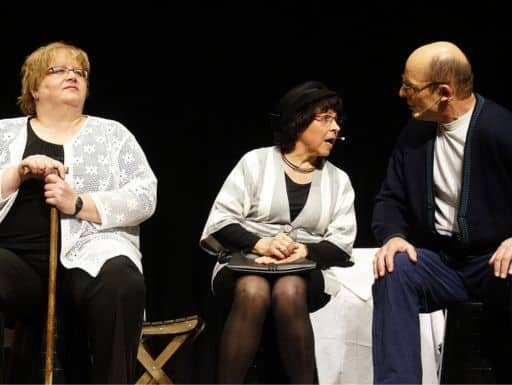15 Team Building Activities for Teachers for Great In-Service Meetings

It’s essential that students learn about teamwork, problem-solving skills, and communication. The reality is that, in today’s fast-paced and ever-changing educational landscape, even teachers are struggling to work together and develop strong relationships with each other.
That’s why we’ve compiled a list of 15 engaging team-building activities that will help you and your fellow educators develop stronger bonds, improve communication, and boost morale. We’ll talk about several types of activities and then provide a few examples of each.
From icebreakers to outdoor games, our list of team-building activities is designed to help you create a positive and supportive work environment, where everyone feels valued and motivated to contribute their best ideas and skills. By incorporating these activities into your in-service meetings, you’ll be able to improve your team’s overall performance, foster a sense of community, and achieve your goals more effectively.
If you’re ready to take your in-service meetings to the next level, join us as we explore 15 of the best team-building activities for teachers.
Icebreakers
Don’t underestimate the power of a good icebreaker! They’re not just for corporate team building events.
A good icebreaker will engage the entire team, not just the loudest and most confident in your group. These icebreakers will get your team thinking outside the box, introduce some fun and laughter into their day, and break them out of their lethargy. By the end, they’ll be all warmed up and ready for the next activity.
1. Bippity Bippity Bop
Imagine Simon Says, but more hectic. The goal is to trick your teammates into making a mistake by responding with the wrong phrase.
To start, gather your staff members in a big circle. Then, choose one person to be the speaker. Have them go from one participant to the next saying either “Bippity Bippity Bop” or “Bop.” If they say “Bippity Bippity Bop,” then the person they’re looking at has to say “Bop” before the speaker finishes. But if they say “Bop,” then the person being looked at needs to stay quiet. If they respond incorrectly, they’re out!
Naturally, the speaker will start to understand that moving and speaking quickly is the best way to eliminate players. Once everyone starts getting the hang of it, you can start introducing new rules.
2. Seven-Card Stud
Small groups of seven are ideal for other team-building activities for teachers, so seven-card stud happens to be an excellent icebreaker for larger groups. Give each team member one playing card. Then, tell them to work among each other to form a winning hand of seven-card stud. There’s a great team-building opportunity here in that there’s always at least one person who knows their poker hands and can share their knowledge with those who don’t.
3. Shrinking Disk
Want to encourage some out-of-the-box thinking from the get-go? To play shrinking disk, pass out paper plates—or something else representing a placeholder—to each person. Have them place the toe of their shoe on the edge of the plate. Then, direct them to move to a different plate. Remove some of the plates and, once again, tell them to move to a different plate. Confusion will begin to set in as they realize there aren’t enough plates (especially after you urge them to hurry up and find a new one!). Once they figure out that it’s allowed to have multiple people at one plate, they’ll begin to automatically form equal groups at each plate. Just keep removing disks until you have the desired number of groups. For especially large groups, you can use a hula hoop in place of plates.
Collaborative Games
Icebreakers are fun, but their main purpose is to get your group of teachers warmed up and ready for the next set of activities. Collaborative games are great team building activities, because that’s where you can focus in on critical thinking, communication skills, and problem solving.
Depending on your group, you might find that separating them into small teams and introducing a little competition is the key to firing them up. For less competitive groups, you can opt for team-building games that establish a common goal for everyone.
4. Escape Rooms
Escape rooms have become more popular in recent years, and they make for a great team building activity. They’re essentially a puzzle that takes the form of a locked room—with participants locked inside.
In order to create an immersive experience, the rooms are dressed up with various props and decorations. Upon taking a closer look at these seemingly random props, observant participants will find they may represent riddles and codes that must be solved in order to proceed to the next step. Escape rooms will challenge your participants’ critical thinking skills, test their communication, and encourage them to work in teams—especially if you pit teams against each other to finish the fastest.
5. Solve A Murder
It’ll take some planning and research, but if you can craft a fun mystery for your school staff to solve, it’ll be one in-service meeting they’ll never forget. Out of all the team building games, a well-executed murder mystery is the perfect activity for a few reasons.
For one, it has a built-in team element: suspects vs detectives. Teams will be able to bond over their shared objectives in a format that everyone can get excited about (who doesn’t love a good murder mystery?). Second, it allows team members to step out of their usual work environment and away from any negative associations they may have with team building activities. And third, if you direct your suspects to act as certain character types, we promise everyone will have a blast. Suspects will relish the opportunity to let loose as a character, and detectives will get a kick out of watching them. And here’s a bonus tip: the murder mystery makes a great virtual team building activity, too!
6. Minefield
Minefield is an obstacle course, but one that you can create with minimal equipment. To play minefield, make sure you have a large, open space. Then, gather your “mines,” which can be anything from cones, chairs, or crumpled pieces of paper. Set them up throughout the space randomly, and you’re ready to go.
As you might have guessed by the name of the game, the goal of minefield is for team members to navigate around the “mines” without touching any of them. The catch, of course, is that the team member traversing the minefield needs to be blindfolded. The other members must guide them to the finish line using only verbal instructions. If they touch any of the mines, however, they’ll have to go back to the beginning and try again. To make things more exciting, play this as a team game where members will need to race to complete the minefield as quickly as possible.
Outdoor Activities
Sometimes what your team needs is a change of environment. Teachers spend the whole school year in the classroom, so they’ll appreciate an in-service meeting that doesn’t take place indoors. Switch it up with some outdoor games, and they’ll gain a whole new perspective for their campus and their colleagues.
7. Sports
Sports and other outdoor activities are perfect team-building exercises for teachers since the campus comes with its own field, playground, or other sports-related equipment. If your team isn’t particularly athletic, you can always simplify the rules to make it an easier game. For example, a quick free-throw competition.
If you want to get even simpler, consider all the sports equipment you have at your disposal to use as part of a more standard team-building activity. For instance, an icebreaker can be modified by including a basketball or tennis ball. Participants can toss the ball to each other, and the person who catches it must tell everyone something about themselves.
8. Scavenger Hunts
A scavenger hunt on a school campus has so much potential as a fun team building activity. Since school campuses have many distinct features and locations, there’s limitless potential for the kinds of clues and challenges you can create. Some clues can test participants’ historical knowledge of the campus, and others can highlight areas that commonly go overlooked. When participants see their campus through the lens of a scavenger hunt, they’ll gain a new perspective that can help inspire them to see things differently.
Scavenger hunts are a fun game that can accommodate many kinds of teams, too. You can configure them for small and big groups alike, with or without competitive elements. Of course, you can also take your scavenger hunt off-campus, such as at a local park or in the city.
9. Photo Challenge
Thanks to smartphones, everyone’s a photographer nowadays.
A photo challenge is a type of scavenger hunt that asks participants to take specific kinds of photographs. The subject of the photographs should often contain the participants in order to facilitate teamwork and communication. The prompts can also provide hints about where a photo should be taken to test your staff’s knowledge of locations on-campus.
Aim for a total list of at least a couple dozen prompts. Some examples to get you inspired include:
- Recreate a childhood photo
- Recreate a famous painting
- Group photo in front of a unique landmark on campus
What’s unique about this kind of scavenger hunt is that you can set a time limit. For example, set a timer for sixty minutes and send the teams out. The winning team is the one that comes back with the most photos taken correctly! Since the hunt is based on a time limit, you won’t need to worry about participants taking too long to reach the end of the challenges, as you would in a normal scavenger hunt.
You can leverage technology even further by using an app to create a shared photo album. Plus, having fun photographs will automatically help create a sense of team unity!
Improv Games
Did you know that improv games are great team building exercises to build trust among team members? They’re also one of the most inexpensive and memorable team building activities for teachers.
For an individual, there’s a lot of pressure in coming up with responses during an improv game. It can even be anxiety-inducing. However, that pressure can be alleviated by sharing the task with other team members. When a team of improv actors is assigned a prompt, they have to trust in each other to carry the scene forward by responding to each other appropriately. This, in turn, builds a form of trust that can help your faculty members learn to depend on each other.
10. One Word Story
This is a simple improv game that everyone can participate in. It even doubles as an icebreaker since it can be played quickly. To start, choose a title an opening line for the story, like “The Mysterious Stranger: No one really knows where the strange came from. He just showed up one day at the…” and then point to the first participant to add a single word to the story. Each person in the group takes turns adding one word to the story. If the story slows down or someone struggles to come up with a word, add a new sentence to keep it moving. Just make sure to leave the sentence open-ended.
11. “Yes, And…”
This is a well-known improv game that will teach your team the value of cooperation. Begin with a short opening statement. Then, the next person will expand your statement with one of their own, but it has to begin with “Yes, and…” The person after that will do the same, and this repeats until someone accidentally starts with “but”, “however,” or another word that disagrees with the statement before it.
To make this a team game, have the participants separate into two groups, with one member of each team facing the other. The two participants will “Yes, and” to each other until one of them fails to think of something or begins with the wrong phrase. Whoever loses goes to the back of their team’s line.
12. Foreign Film Dub
This is a fun activity that involves teams of four, and it will have the entire team improvising at the same time. Two of the team members will perform a scene using gibberish language, while the other two act as “dubbers” who translate the scene into English. To create a successful scene, those using gibberish should incorporate physical actions to help their dubbers understand the story. Short and simple sentences are also recommended to keep the scene cohesive. After the scene is finished, the players switch roles. To add a competitive element to this, a non-participating group can judge which of the two team’s performances they found most entertaining.
Training Seminars
In-service staff meetings should be fun, and they should also be educational. While the activities on this list are great for professional development, it’s also effective to take the direct approach of offering training seminars. If you recognize any specific areas where your team needs improvement, you can target them with team building programs designed specifically to address those weaknesses. You can even survey your staff to find out if there’s any particular kind of training that they feel they might be lacking.
13. Leadership Training
Teachers are leaders of the classroom. But is every teacher using a method of leadership that best suits their strengths?
Being a good leader is a soft skill, and not every teacher has received training on it. Often, they copy the style of leadership that they were taught by others in their field instead of developing their own style based on their own strengths.
If your faculty includes new teaching staff who haven’t yet developed their own style, a seminar could be a great way to improve their leadership skills.
14. Creating a Team Culture
Culture starts at the top with leadership and trickles all the way down. That means that the culture you facilitate among your staff is going to have an impact on the culture that every individual teacher upholds in their classrooms with their students.
The thing about culture is that it has to be created. If leaders lack the ability to enforce their culture, then someone else is going to make the culture for them, and it won’t be the culture they intended.
In order to ensure that your staff is maintaining a positive school culture with the right values, as well as creating healthy ones in their classrooms, consider a training seminar on this subject.
15. Time Management and Organization
From creating lesson plans to grading papers, it’s no secret that teachers have a ton of work. While we trust that teachers know how to use their time to complete their tasks on time, what every human being struggles with is eliminating the hidden “time wasters” that plague their lives.
Consider the expression “death by a thousand cuts.” One minute of wasted time is not going to be a problem, but a thousand wasted minutes throughout the day will eat up a substantial chunk of your time.
Time management training can be a great opportunity to help staff organize their time better, which doesn’t just improve their efficiency—it even reduces their stress!
Final Thoughts
No matter which of the group activities you choose from the list above, the most important thing is that you create an environment full of trust and open communication. The activities listed above are designed to get the entire team involved, but a strong facilitator will be able to engage your staff effectively regardless of what the activity is.




